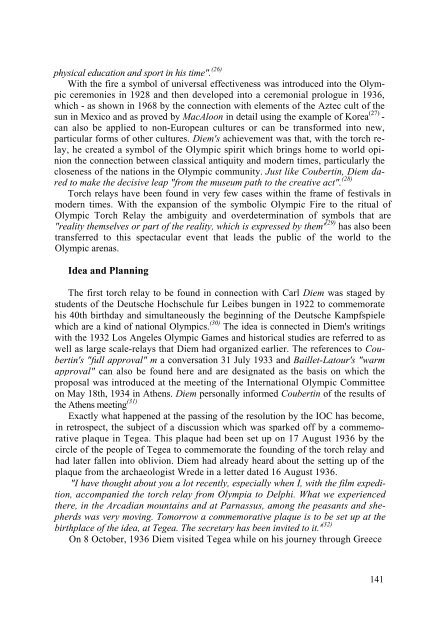You also want an ePaper? Increase the reach of your titles
YUMPU automatically turns print PDFs into web optimized ePapers that Google loves.
physical education and sport in his time". (26)<br />
With the fire a symbol of universal effectiveness was introduced into the Olympic<br />
ceremonies in 1928 and then developed into a ceremonial prologue in 1936,<br />
which - as shown in 1968 by the connection with elements of the Aztec cult of the<br />
sun in Mexico and as proved by MacAloon in detail using the example of Korea (27) -<br />
can also be applied to non-European cultures or can be transformed into new,<br />
particular forms of other cultures. Diem's achievement was that, with the torch relay,<br />
he created a symbol of the Olympic spirit which brings home to world opinion<br />
the connection between classical antiquity and modern times, particularly the<br />
closeness of the nations in the Olympic community. Just like Coubertin, Diem dared<br />
to make the decisive leap "from the museum path to the creative act". (28)<br />
Torch relays have been found in very few cases within the frame of festivals in<br />
modern times. With the expansion of the symbolic Olympic Fire to the ritual of<br />
Olympic Torch Relay the ambiguity and overdetermination of symbols that are<br />
"reality themselves or part of the reality, which is expressed by them' (29) has also been<br />
transferred to this spectacular event that leads the public of the world to the<br />
Olympic arenas.<br />
Idea and Planning<br />
The first torch relay to be found in connection with Carl Diem was staged by<br />
students of the Deutsche Hochschule fur Leibes bungen in 1922 to commemorate<br />
his 40th birthday and simultaneously the beginning of the Deutsche Kampfspiele<br />
which are a kind of national Olympics. (30) The idea is connected in Diem's writings<br />
with the 1932 Los Angeles Olympic Games and historical studies are referred to as<br />
well as large scale-relays that Diem had organized earlier. The references to Coubertin's<br />
"full approval" m a conversation 31 July 1933 and Baillet-Latour's "warm<br />
approval" can also be found here and are designated as the basis on which the<br />
proposal was introduced at the meeting of the International Olympic Committee<br />
on May 18th, 1934 in Athens. Diem personally informed Coubertin of the results of<br />
the Athens meeting (31)<br />
Exactly what happened at the passing of the resolution by the IOC has become,<br />
in retrospect, the subject of a discussion which was sparked off by a commemorative<br />
plaque in Tegea. This plaque had been set up on 17 August 1936 by the<br />
circle of the people of Tegea to commemorate the founding of the torch relay and<br />
had later fallen into oblivion. Diem had already heard about the setting up of the<br />
plaque from the archaeologist Wrede in a letter dated 16 August 1936.<br />
"I have thought about you a lot recently, especially when I, with the film expedition,<br />
accompanied the torch relay from Olympia to Delphi. What we experienced<br />
there, in the Arcadian mountains and at Parnassus, among the peasants and shepherds<br />
was very moving. Tomorrow a commemorative plaque is to be set up at the<br />
birthplace of the idea, at Tegea. The secretary has been invited to it.' (32)<br />
On 8 October, 1936 Diem visited Tegea while on his journey through Greece<br />
141

















